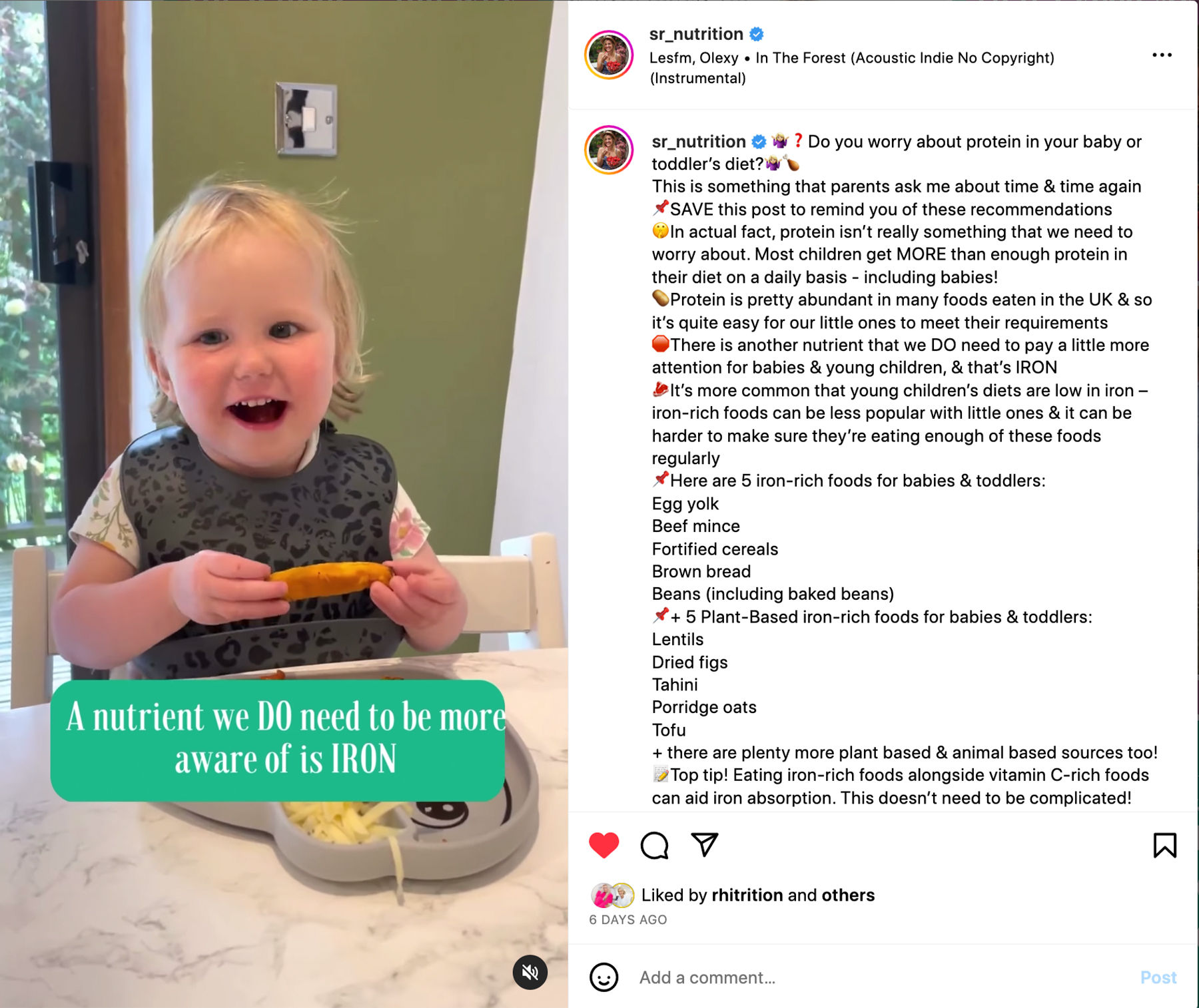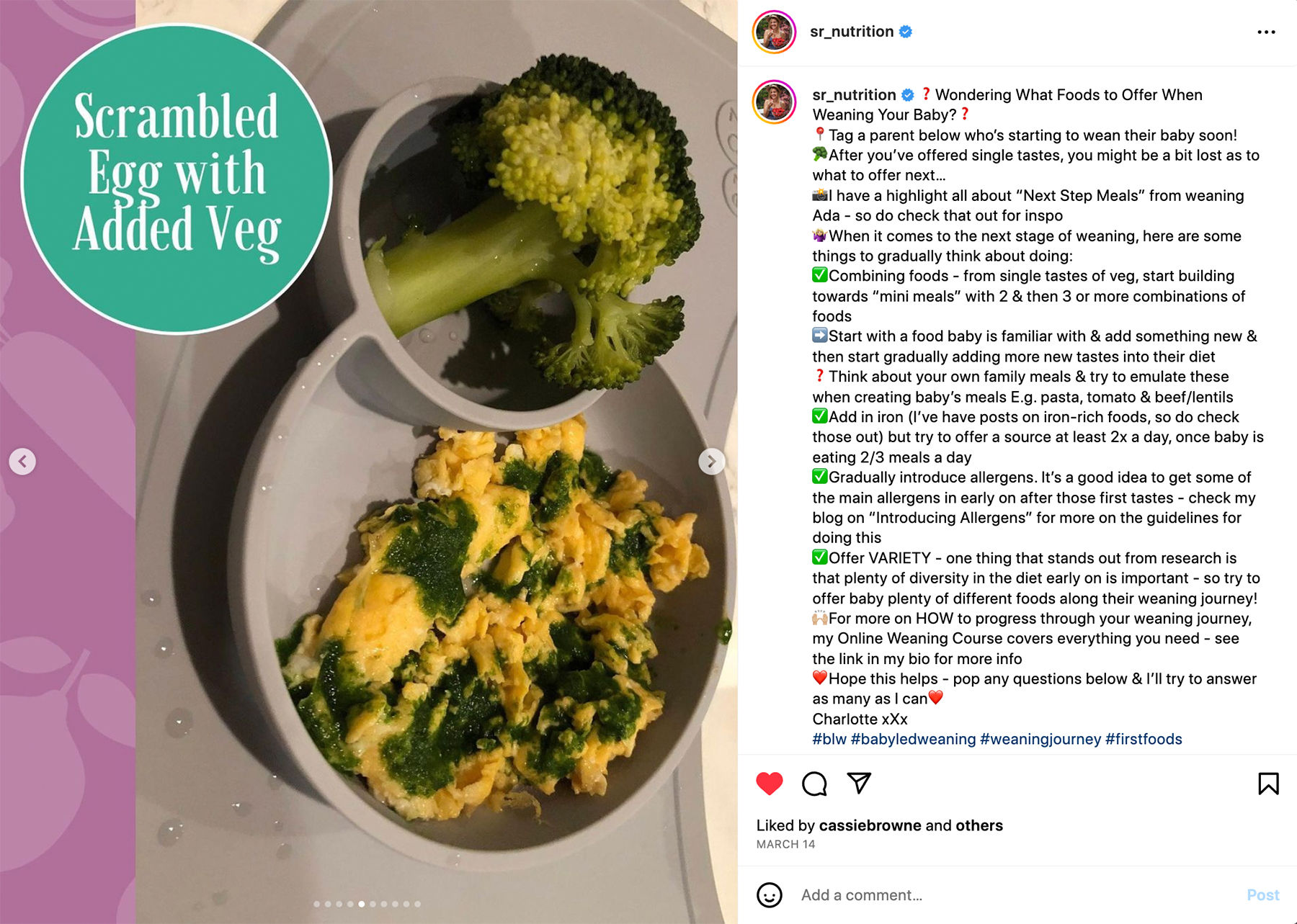Use arrow keys to navigate through the menu items. Use Tab key to navigate through the menu banners.
Family Meals

Family Meals
By the age of 7-9 months, most babies will be eating three meals a day. Weaning expert Charlotte Stirling-Reed (@sr-nutrition) explains how to get there
When it comes to weaning, I find parents have LOTS of questions, and rightly so. Many parents really want to “get it right”, but sometimes the best thing you can do is to help your baby explore, have fun with foods and bring them into your family mealtimes as much as possible.
How to establish a routine
When weaning starts it’s a good idea to kick off with just ONE meal a day. This allows your baby to get used to the idea of “eating” rather than feeding, and to the concept of sitting down for meals. Whether you’re starting with purees or going for baby-led weaning, offering one small meal a day allows your baby to get used to foods gradually, without it all being too overwhelming. The very start of weaning is more about exploration than it is about getting your little one to eat lots of foods.
However, it is a good idea to start offering meals at a time of day that really works for you and your family, a time when everything is calm and no one is rushing or busy with other things. This gives you and your baby space and time to enjoy mealtimes together – to make it more of a fun event than a daily chore. Offer food at similar times each day so your baby starts to understand the idea of mealtimes and learns when to expect food. Babies love routine and they love familiarity, so this can help those mealtimes go more smoothly.
Once your baby seems to be enjoying their food and exploring it, you can gradually move from one meal a day, to two meals a day, to three meals a day. For some babies this might happen quickly – over just a couple of weeks – and for others this might happen over a couple of months. Babies are all different, so let them go at their own pace, but try to stick to a rough structure around mealtimes. You don’t have to offer meals at EXACTLY the same times each day, but having a familiar pattern can help babies to accept them more readily.

How to offer family meals
If you wish, you can involve your baby in family meals right from the start, just by offering baby suitable pieces of your own food, such as a chunk of well-cooked salmon, a soft broccoli floret, a slice of ripe avocado or some potato without skin on.
Offering food from family meals can: .
-
help baby get used to the tastes and flavours of your own family food
-
help baby explore more textures and foods
-
help your baby to copy you and eat the same foods you’re eating
-
reduce food waste
-
mean less time cooking and prepping food for you
Conversely, when you first start weaning you might want to give baby separate meals, whether food pieces or purees, so they can explore foods that you don’t eat regularly as a family. Preparing food separately may also be an easier way of offering allergens one at a time.
Building up to a meal
Start baby’s weaning journey with SINGLE tastes of veggies, ideally beginning with the bitter or more neutral flavours. These could either be as purees or as pieces of food, such as sticks of soft avocado, well-cooked broccoli florets or potato fingers with the skin removed.
Gradually offer more ingredients at each mealtime until you’re offering mini versions of the meals you have yourself. For example, spaghetti bolognaise with the pasta mashed up, a curry with the veggies and meats blended (going easy on the spice), or fish sandwiches cut into finger sticks for baby to feed to themselves. It’s all about adapting and editing the foods you give baby to ensure they are suitable for their age and skill set. Find out what foods to avoid between 6-12 months here.
How to make mealtimes enjoyable
There are two key ways to enjoy the process and have fun together.
-
Take the pressure off. Don’t force your little one to eat anything they don’t want, and take the pressure and expectation off yourself, too.
-
Connect. Ideally sit down together and try to make mealtimes a time for some connection and nurturing. Talk and laugh and have plenty of eye contact during meals – this will help your baby to feel confident and safe. If baby associates mealtimes with “fun time with my parent”, guess what, they’ll want to go back there day after day!

Food ideas
As your little one starts exploring more varieties of food, you could try some of my favourite options.
-
Scrambled egg with spinach or well-chopped tomatoes. Scrambled egg makes a great texture for babies. It’s bumpy but super soft and easy to eat from a spoon or fingers. I like to mix it with flavours like pureed spinach or tomato salsa.
-
Easy mash. Take any ingredients you have that need using up, such as butternut squash, chickpeas or some chicken. Cook the ingredients in a pan and then mash or blend together with a little flavour, such as cumin, or some cream cheese. You can also use parts of your own dinner, separated and mashed. Here’s my recipe for sweet potato, butterbean and cumin mash.
-
Fritters. These are another great way to help baby explore new flavours and to practise self-feeding. Fritters have always been a popular recipe of mine and it’s so easy to adapt the veg or flavour that you use.
-
Potato tots. These are easy to make and they’re great for babies to explore. Cook potatoes, salmon and peas and mash them together a little and form into little balls, then bake in the oven for 15 minutes or so, and offer to baby to self-feed. You can also offer this as a mash and skip the oven.
-
Porridge. This is quick, easy to adapt and you can pack it with flavour and nutrients as your little one gets older: try my carrot cake porridge. Oats are a great food containing fibre, wholegrains, iron and protein.
-
Avocado and lentil pasta. Take a ripe avocado and mash it with a spoonful of tinned lentils, then add it to some cooked fusilli pasta. Baby can help themselves, or you can offer it on a spoon. Here’s a version of it.
About Charlotte
Charlotte Stirling-Reed is “The Baby & Child Nutritionist” and is a Registered Nutritionist with the Association for Nutrition. Charlotte is also author of the bestselling book How to Wean Your Baby and is mum to little foodies Raffy and Adaline.
Check out her Online Weaning Course for everything you need to know about weaning, including recipes, choking vs gagging, introducing allergens and so much more.
Help & Customer service
- Help Centre
- How to shop
- Product recalls
Payment Methodslist with 8 items
- Asda Group of Companies
- Modern Slavery Statement
- Electrical Waste Recycling
- Terms & Conditions
- Customer Review Policy
- Privacy Centre
- Cookie Settings
- Accessibility
© ASDA 2025